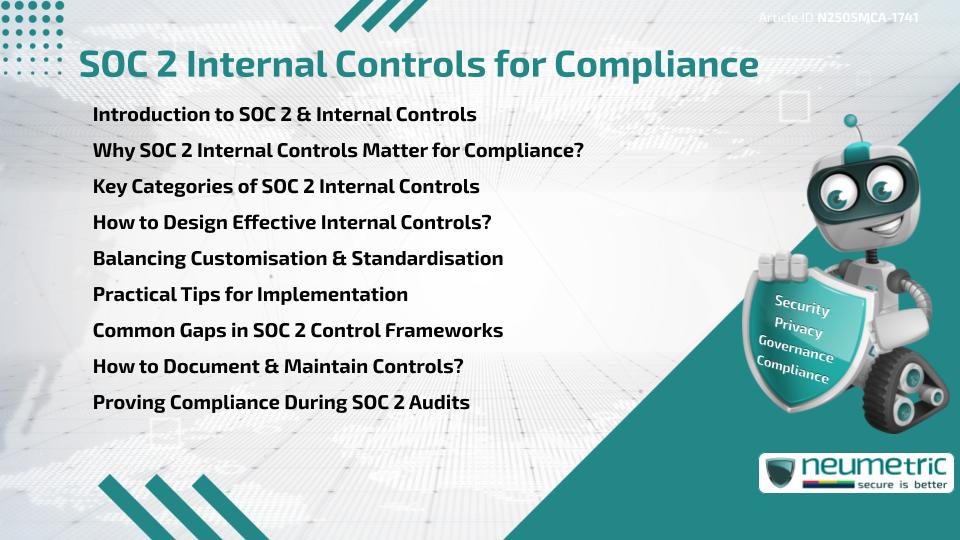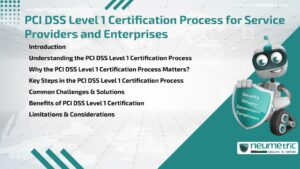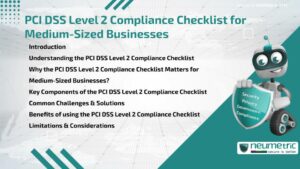Table of Contents
ToggleIntroduction to SOC 2 & Internal Controls
SOC 2 is an Audit Framework designed to help Service organisations—especially in the Cloud & SaaS sectors—demonstrate Control over their Systems. At its core are SOC 2 Internal Controls for Compliance, which define how Companies protect User Data & Ensure Operational Integrity.
Why SOC 2 Internal Controls Matter for Compliance?
Internal Controls serve as the Operational backbone of SOC 2. Without Well-defined Controls, organisations cannot meet the Trust Services Criteria covering Security, Availability, Processing Integrity, Confidentiality & Privacy.
SOC 2 Internal Controls for Compliance help build Customer Trust & Reduce the Risk of Breaches. They also simplify Vendor onboarding processes for Clients in regulated sectors.
Read more about Trust Services Criteria.
Key Categories of SOC 2 Internal Controls
SOC 2 Internal Controls for Compliance fall into several Core categories:
- Access Control
- Change Management
- System Operations
- Risk Mitigation
- Incident Response
- Data Security & Confidentiality
Each category addresses one or more of the Trust Services Criteria & Should be adapted based on the Company’s specific Risk landscape.
Explore these categories further at ISACA’s Control Library.
How to Design Effective Internal Controls?
Designing effective Controls starts with understanding Business Processes & Data flows. Internal Controls should:
- Be specific to the Environment
- Be aligned with SOC 2 Goals
- Involve Technical & Administrative Safeguards
- Have clear Ownership & Accountability
Avoid generic Templates. Instead, Review what each Control is meant to accomplish, then tailor it accordingly.
Balancing Customisation & Standardisation
While SOC 2 is flexible, Over-customising can lead to confusion during Audits. Try to keep Controls consistent across Teams & Systems. Leverage NIST CSF or ISO 27001 Frameworks as references without copying them directly.
Practical Tips for Implementation
To integrate SOC 2 Internal Controls for Compliance smoothly:
- Involve both IT & Compliance Stakeholders
- Document Control descriptions & frequency
- Use Automation Tools for Access Logs & Change Control
- Conduct Periodic Reviews
Refer to Cloud Security Alliance for Cloud-specific guidance.
Common Gaps in SOC 2 Control Frameworks
Some Companies overlook Policy enforcement or rely too much on informal practices. Others fail to Monitor System activity or ignore User Offboarding Procedures. These Gaps can lead to Audit failures even when Technology is in place.
How to Document & Maintain Controls?
Good Documentation should explain:
- What the Control does?
- Why it is needed?
- Who owns it?
- How often it runs?
Use version Control systems & ensure that updates reflect actual practices.
Proving Compliance During SOC 2 Audits
Auditors expect Evidence of Control execution. That includes Logs, Screenshots, Reports & Access history. SOC 2 Internal Controls for Compliance should not only exist—they must work consistently over time.
Takeaways
- SOC 2 Internal Controls for Compliance protect User Trust & Data integrity
- Controls must be tailored, consistent & well-documented
- Include both Technical & Administrative Safeguards
- Regular reviews & clear Ownership are essential
- Evidence matters more than intent during Audits
FAQ
What are SOC 2 Internal Controls?
They are Policies, Processes & Tools that ensure a Company meets SOC 2’s Security & Trust Criteria.
How do Controls affect SOC 2 Audit Outcomes?
Strong Controls reduce risk & demonstrate Compliance, which improves Audit Results.
Do Internal Controls include Training?
Yes, Employee Awareness & Response Policies are part of Internal Controls.
Are SaaS-specific Controls different?
Yes, Cloud-native Setups may require Controls around Multi-tenant Security & Third Party dependencies.
Can Internal Controls be reused for other Frameworks?
Yes, many Controls align with ISO 27001 or NIST Standards.
References
- AICPA Trust Services Criteria
- ISACA Resource Hub
- NIST Cybersecurity Framework
- Cloud Security Alliance
- ISO 27001 Overview
Need help?
Neumetric provides organisations the necessary help to achieve their Cybersecurity, Compliance, Governance, Privacy, Certifications & Pentesting goals.
Organisations & Businesses, specifically those which provide SaaS & AI Solutions, usually need a Cybersecurity Partner for meeting & maintaining the ongoing Security & Privacy needs & requirements of their Clients & Customers.
SOC 2, ISO 27001, ISO 42001, NIST, HIPAA, HECVAT, EU GDPR are some of the Frameworks that are served by Fusion – a centralised, automated, AI-enabled SaaS Solution created & managed by Neumetric.
Reach out to us!





